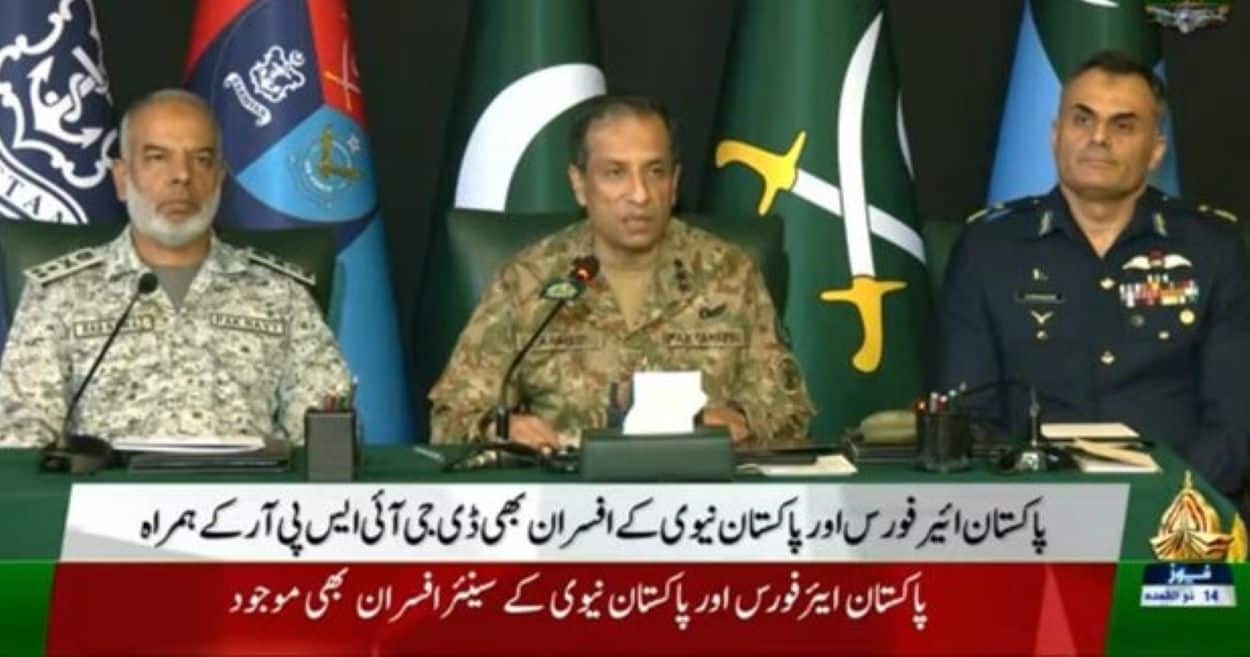Pakistan’s Director General Inter-Services Public Relations (DG ISPR) Lieutenant General Ahmed Sharif Chaudhry clarified on May 11, 2025, that India, not Pakistan, sought a ceasefire through the U.S. and other allies, following Pakistan’s Operation Bunyaan al Marsoos, which targeted 26 Indian military sites in retaliation for Indian aggression.
The operation, a tri-services effort, showcased Pakistan’s advanced military capabilities while avoiding civilian casualties, reinforcing its commitment to sovereignty and restrained response.
Chaudhry, joined by PAF Air Vice Marshal Aurangzeb Ahmed and Vice Admiral Raja Rab Nawaz, emphasised that Pakistan never requested the ceasefire announced by U.S. President Donald Trump on May 10. “India requested it after our response on May 10,” he stated, noting India’s Ministry of Defence and Armed Forces publicly called for de-escalation. Effective at 5 p.m. IST, the ceasefire followed Pakistan’s decisive strikes, mediated by U.S. Secretary of State Marco Rubio and others.
DG ISPR confirms India sought a ceasefire after Operation Bunyaan al Marsoos targeted 26 military sites, including India’s S-400 system.
Operation Bunyaan al Marsoos Details
Launched on May 10 in response to India’s May 9 airstrikes on three PAF bases—Nur Khan, Murid, and Shorkot. Operation Bunyaan al Marsoos struck 26 targets, including airbases at Suratgarh, Sirsa, Adampur, BrahMos facilities, and the S-400 system at Adampur and Bhuj.
The operation destroyed military headquarters, logistics sites, and proxy facilities in Indian-administered Kashmir and mainland India, using precision-guided Fateh-series missiles, loitering munitions, and cyber offensives that crippled 70% of India’s power grid, per unverified claims.
Chaudhry highlighted the operation’s “textbook” tri-services integration, leveraging network-centric warfare and real-time situational awareness. The PAF, led by Air Chief Marshal Zaheer Ahmad Babar, targeted the most Indian airfields since 1971, grounding Rafale jets and neutralising threats with precision to avoid civilian harm.
The Navy tracked India’s INS Vikrant, deterring maritime escalation. Pakistan downed 84 Indian drones, showcasing robust air defences. Chaudhry stressed, “Our religion, culture, and professionalism don’t allow us to target civilians.”
Strategic Context
The conflict, sparked by India’s April 22 Pahalgam attack accusations, saw India’s Operation Sindoor kill 31 Pakistani civilians, prompting Pakistan’s retaliation, including downing five Indian jets. Chaudhry accused India of sponsoring terrorism in Khyber Pakhtunkhwa and Balochistan to distract Pakistan. Despite this, Pakistan conducted simultaneous counter-terrorism operations, demonstrating resilience. The DG ISPR dismissed claims of an Indian pilot in custody as “fake news.”
Read: Trump Praises India-Pakistan Ceasefire, Signals Trade Boost and Kashmir Talks
Operation Bunyaan al Marsoos underscores Pakistan’s military strength and restraint, reshaping India-Pakistan dynamics post-ceasefire.
*This information is sourced from ISPR’s press conference and credible reports.






